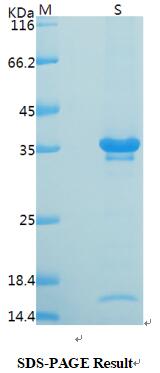Product Name :
Integrin α3 (CD49c) Recombinant Protein Swiss-Prot :
P26006 Host :
E.coli Tag :
≥0.5mg/ml Amino acid Sequence :
FGYSVALHRQTERQQRYLLLAGAPRELAVPDGYTNRTGAVYLCPLTAHKDDCERMNITVKNDPGHHIIEDMWLGVTVASQGPAGRVLVCAHRYTQVLWSGSEDQRRMVGKCYVRGNDLELDSSDDWQTYHNEMCNSNTDYLETGMCQLGTSGGFTQNTVYFGAPGAYNWKGNSYMIQRKEWDLSEYSYKDPEDQGNLYIGYTMQVGSFILHPKNITIVTGAPRHRHMGAVFLLSQEAGGDLRRRQVLEGSQVGAYFGSAIALADLNNDGWQDLLVGAPYYFERKEEVGGAIYVFMNQAGTSFPAHPSLLLHGPSGSAFGLSVASI Restriction sites :
NdeI-XhoI Background :
Integrins are heterodimers composed of non-covalently associated transmembrane α and β subunits. The 16 α and 8 β subunits heterodimerize to produce more than 20 different receptors. Most integrin receptors bind ligands that are components of the extracellular matrix, including Fibronectin, Collagen and Vitronectin. Certain integrins can also bind to soluble ligands such as Fibrinogen, or to counterreceptors on adjacent cells such as the intracellular adhesion molecules (ICAMs), leading to aggregation of cells. Ligands serve to cross-link or cluster integrins by binding to adjacent integrin receptors; both receptor clustering and ligand occupancy are necessary for the activation of integrin-mediated responses. In addition to mediating cell adhesion and cytoskeletal organization, integrins function as signaling receptors. Signals transduced by integrins play a role in many biological processes, including cell growth, differentiation, migration and apoptosis. The Integrin α3 chain, also known as very late (activation) antigen 3 (VLA-3), very common antigen 2 (VCA-2), extracellular matrix receptor 1 (ECMR1) and galactoprotein b3 (GAPB3), undergoes posttranslational cleavage in the extracellular domain to yield disulfide-linked light and heavy chains that join with β1 to form an integrin that interacts with many extracellular-matrix proteins. Soluble :
PBS, 4M Urea, PH7.4 Purification&Purity :
Transferred into competent cells and the supernatant was purified by NI column affinity chromatography and the purity is > 85% (by SDS-PAGE). Storage&Stability :
Store at 4°C short term. Aliquot and store at -20°C long term. Avoid freeze-thaw cycles. Expression vector :
pet-22b(+) BiowMW :
~36kDa Note :
For research use only, not for use in diagnostic procedure. concentration :
≥0.5mg/ml
Integrin α3 (CD49c) Recombinant Protein Swiss-Prot :
P26006 Host :
E.coli Tag :
≥0.5mg/ml Amino acid Sequence :
FGYSVALHRQTERQQRYLLLAGAPRELAVPDGYTNRTGAVYLCPLTAHKDDCERMNITVKNDPGHHIIEDMWLGVTVASQGPAGRVLVCAHRYTQVLWSGSEDQRRMVGKCYVRGNDLELDSSDDWQTYHNEMCNSNTDYLETGMCQLGTSGGFTQNTVYFGAPGAYNWKGNSYMIQRKEWDLSEYSYKDPEDQGNLYIGYTMQVGSFILHPKNITIVTGAPRHRHMGAVFLLSQEAGGDLRRRQVLEGSQVGAYFGSAIALADLNNDGWQDLLVGAPYYFERKEEVGGAIYVFMNQAGTSFPAHPSLLLHGPSGSAFGLSVASI Restriction sites :
NdeI-XhoI Background :
Integrins are heterodimers composed of non-covalently associated transmembrane α and β subunits. The 16 α and 8 β subunits heterodimerize to produce more than 20 different receptors. Most integrin receptors bind ligands that are components of the extracellular matrix, including Fibronectin, Collagen and Vitronectin. Certain integrins can also bind to soluble ligands such as Fibrinogen, or to counterreceptors on adjacent cells such as the intracellular adhesion molecules (ICAMs), leading to aggregation of cells. Ligands serve to cross-link or cluster integrins by binding to adjacent integrin receptors; both receptor clustering and ligand occupancy are necessary for the activation of integrin-mediated responses. In addition to mediating cell adhesion and cytoskeletal organization, integrins function as signaling receptors. Signals transduced by integrins play a role in many biological processes, including cell growth, differentiation, migration and apoptosis. The Integrin α3 chain, also known as very late (activation) antigen 3 (VLA-3), very common antigen 2 (VCA-2), extracellular matrix receptor 1 (ECMR1) and galactoprotein b3 (GAPB3), undergoes posttranslational cleavage in the extracellular domain to yield disulfide-linked light and heavy chains that join with β1 to form an integrin that interacts with many extracellular-matrix proteins. Soluble :
PBS, 4M Urea, PH7.4 Purification&Purity :
Transferred into competent cells and the supernatant was purified by NI column affinity chromatography and the purity is > 85% (by SDS-PAGE). Storage&Stability :
Store at 4°C short term. Aliquot and store at -20°C long term. Avoid freeze-thaw cycles. Expression vector :
pet-22b(+) BiowMW :
~36kDa Note :
For research use only, not for use in diagnostic procedure. concentration :
≥0.5mg/ml
Blocking peptide available as NCP0243P

 Integrin α3 (CD49c) Recombinant Protein
Integrin α3 (CD49c) Recombinant Protein 
 Datasheet
Datasheet COA
COA MSDS
MSDS SHIP
SHIP